Artificial brain cells could now be implanted in the brain to repair the damage caused by chronic diseases, such as Alzheimer’s disease and other neurodegenerative conditions, thanks to a team of scientists who created bionic neurons that work like the real thing.
A team of scientists at the University of Bath created artificial neurons that could potentially help overcome paralysis, connect minds to machines, and restore failing brain circuits.
The new technology can help patients who have degenerative diseases affecting the brain.
Just like real neurons, the bionic neurons, which were described in a study published in Nature Communications, receive electrical signals from healthy neurons, process them, and send new signals to other neurons, muscles or organs in the body.

One of the tiny chips in its protective casing.
Challenging but worth the wait
Aside from working like real neurons, the artificial brain cells require only 40 nanowatts of power, which is one-billionth the power of a microprocessor. The invention is the fruit of years of collaboration and hard work, which faced many struggles along the way.
It took decades for scientists to design artificial neurons that respond to electrical signals from the nervous system. The new technology could open new possibilities in the cure and treatment of conditions wherein the neurons are faulty and are not properly working. Using artificial neurons, the scientists believe that can repair diseased bio-circuits by duplicating their proper functioning and responding properly to biological feedback to restore body functions.
For instance, in people with heart failure, the neurons in the brain base do not respond appropriately to the nervous system feedback and do not send the correct signals to the heart, unable to pump properly as well. If the patients have artificial neurons, their hearts will normally work again.
The scientists plan to replicate the artificial neurons since they can be used in the treatment of brain illnesses that are characterized by brain cell death, including Alzheimer’s disease.
“Until now, neurons have been like black boxes, but we have managed to open the black box and peer inside. Our work is paradigm-changing because it provides a robust method to reproduce the electrical properties of real neurons in minute detail,” Professor Alain Nogaret, from the University of Bath’s department of physics, said.
World first as artificial neurons developed to cure chronic diseases
Neuron response to electrical stimuli
The researchers derived equations that shed light on how nerve cells respond to electrical stimuli from other nerves. Though the process is complicated since the responses are non-linear, they might be three times bigger or more. Further, the team devised silicon chips that accurately modelled biological ion channels, imitating real and live neurons that can respond to a broad range of stimulations.
After successfully replicating the processes and dynamics of respiratory and hippocampal in laboratory mice, the researchers believe that they are a step closer to creating the world’s first artificial neurons to help curb many diseases and help thousands of people.
“Until now neurons have been like black boxes, but we have managed to open the black box and peer inside. Our work is paradigm changing because it provides a robust method to reproduce the electrical properties of real neurons in minute detail,” Prof. Nogaret said.
He explained that the team’s approach incorporates many breakthroughs, and now, they can estimate the accurate parameters that control any nerve cell behavior with high precision.
“We have created physical models of the hardware and demonstrated its ability to successfully mimic the behaviour of real living neurons. Our third breakthrough is the versatility of our model which allows for the inclusion of different types and functions of a range of complex mammalian neurons,” he added.
The team is hopeful that they can finally use their model. The study opens up a broad range of possibilities in repairing the nerve cell that have been lost or had died due to degenerative disease, such as Alzheimer’s and heart disease.
The study was carried out with the help of the University of Bristol, University of Zurich, and University of Auckland.
Journal reference:
Abu-Hassan, K., Taylor, J.D., Morris, P.G. et al. Optimal solid state neurons. Nat Commun 10, 5309 (2019) doi:10.1038/s41467-019-13177-3, https://www.nature.com/articles/s41467-019-13177-3